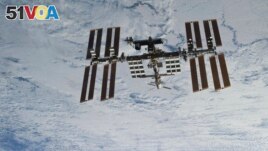13 February 2022
The American space agency NASA says it will keep supporting the International Space Station (ISS) through 2030. After that, it plans to retire the ISS and use privately developed stations.
NASA recently released a report on its plans for transitioning from the ISS to one or more space stations that would be developed by private companies.
The ISS has been operating for more than 20 years. The first piece of the floating space laboratory was launched into space in 1998. The ISS has been widely praised as a scientific success. But NASA and its international partners have recognized that it cannot continue to operate forever.

In this NASA photo, backdropped against clouds over Earth, the International Space Station is seen from Space Shuttle Discovery as the two orbital spacecraft accomplish their relative separation on March 7, 2011. (NASA via AP)
Late last year, the administration of U.S. President Joe Biden announced it was committed to extending ISS operations through 2030. In a statement, NASA Administrator Bill Nelson said the plan would include continued cooperation with international partners from Europe, Japan, Canada and Russia.
Last month, NASA released a report to the United States Congress on its plans to keep the ISS operating over the next eight years.
The report said NASA officials look forward to the final years of the ISS being its most productive. This will be a time in which NASA will aim "to support deep space exploration and continue to return medical and environmental benefits to humanity..." the report reads.
NASA notes in the report that the ISS is currently the busiest it has ever been, with the addition of private space companies now transporting astronauts and supplies.
In the future, NASA says its goal is to completely move to privately developed space laboratories for all its space lab needs. This way, NASA will be paying the space station operators "only for the goods and services the agency needs."
NASA has already chosen three private American companies to develop future space stations.
One of them will be led by Blue Origin. The company announced plans last October for its "Orbital Reef" station. The developers say Orbital Reef will support 10 people in an area of about 830 cubic meters. That is nearly the size of the ISS. The station will be designed to serve science researchers, space agencies, nations without space programs and technology and manufacturing companies.
Another developer will be space services company Nanoracks. It has said it is teaming up with Voyager Space and Lockheed Martin to develop "the first-ever free flying commercial space station." The companies say they expect the space laboratory, named "Starlab," to be operational by 2027.
The third company, Northrop Grumman, said it will develop a "free-flying space station" for NASA. In an announcement in December, the defense contractor said the station is expected to support activities including "science, tourism and industrial experimentation."
In its report to Congress, NASA also describes its plans for retiring the ISS. When it is ready to end service, the space agency said it would first take steps to "begin slowly lowering the operational altitude of the ISS."
Then, it would attempt to carry out a controlled de-orbit of the floating lab with the help of additional space vehicles.
The plan is to target the space station toward the South Pacific Ocean at a place called Point Nemo. This is a stretch of open water between New Zealand and the southernmost part of South America. The U.S. National Ocean Service identifies Point Nemo as the point in the ocean that is farthest from land.
The area has repeatedly been used by space agencies seeking to safely de-orbit old spacecraft so they do not cause problems in space or on the ground. Most parts of the ISS are expected to burn up as they pass through Earth's atmosphere. But some pieces might reach Earth. That is why NASA says it would send the ISS to Point Nemo on its final trip.
I'm Bryan Lynn.
Bryan Lynn wrote this story for VOA Learning English, based on reports from NASA and Reuters.
We want to hear from you. Write to us in the Comments section, and visit 51VOA.COM.
Words in This Story
transition – n. a change from one system or method to another
committed – adj. loyal and willing to give your time and energy to something you believe in
benefit – n. a good or helpful result
tourism – n. the activity of traveling to a place for pleasure
altitude – n. the height of something above sea level












